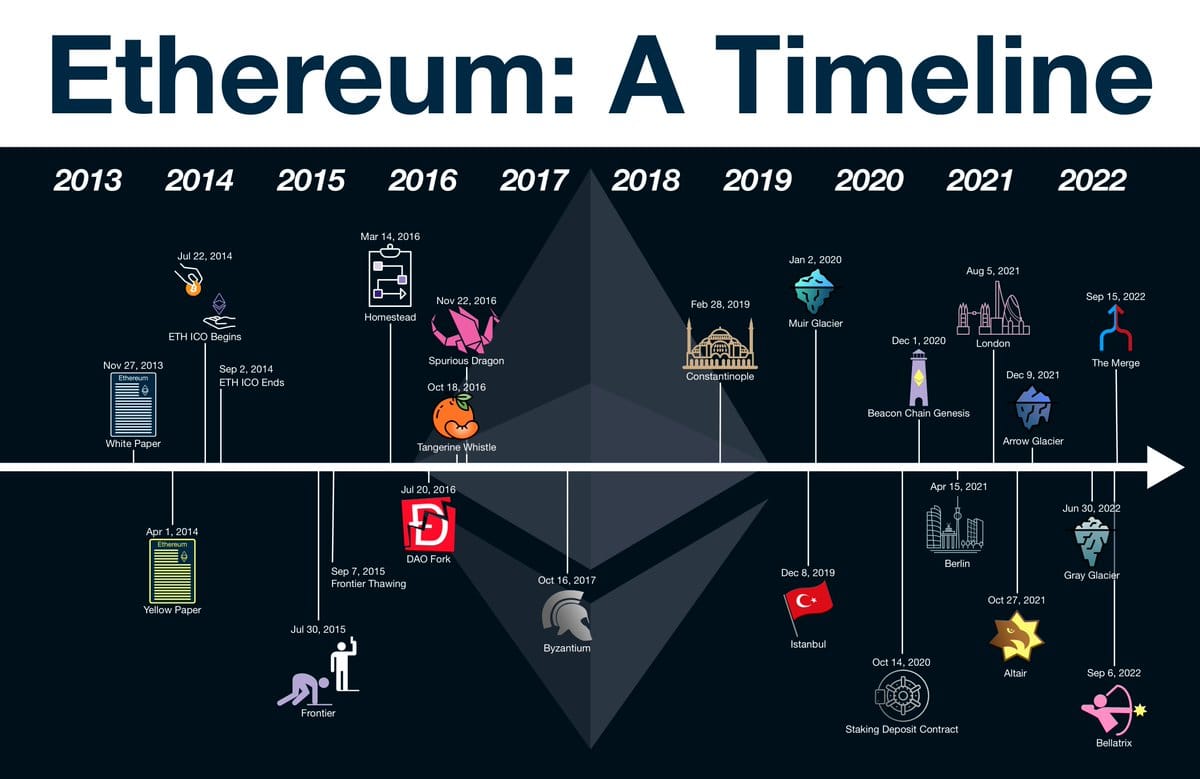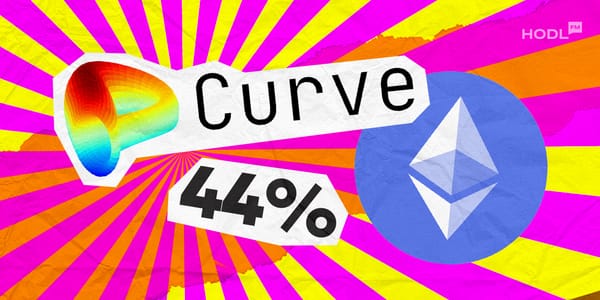Except if you live in the North Pole or underground, there's no way you wouldn't have heard of Ethereum. It's the second most prominent name in the world of cryptocurrencies, next only to Bitcoin.
Related: What is Solana? Explainer
Ethereum was supposed to be the Bitcoin killer, but even though it has not succeeded in its assassination attempts, it has made a really big name for itself. However, behind the big name, the complicated crypto tech, and all the glamour, what really is Ethereum? This is where you find out.
Overview
Ethereum, Ether, ETH (not to be confused with Erik Ten Hag), or whatever else people call it, is a decentralized global software platform powered by blockchain technology. It is used in blockchain and decentralized finance application development.
Although the platform is used primarily for blockchain and DeFi, it can do much more. Ethereum is designed to be scalable, programmable, secure, and decentralized. The Ether coin (ETH) was designed to pay for work done on the blockchain, but let's just say things got out of hand because now you can pay for tacos with Ether as long as the seller accepts it.
Origin and History of Ethereum
Ethereum came to life from Vitalik Buterin's mind and was shown to the world in 2014 through its whitepaper. In 2015, Buterin and Joe Lubin launched it.
But Lubin and Buterin imagined their brainbaby as more than a virtual payment platform. Their exploration of the potential of blockchain technology has given us the multipurpose, comprehensive blockchain and DeFi platform we all know and love today.
Ethereum spawned a new variant called “Ethereum Classic” in 2016 when some users stole Ethereum worth more than $50 million. What to do next split the Ethereum community into two factions; some community members wanted to reverse the theft by getting rid of the current Ethereum blockchain, which makes the stolen money useless, and others wanted to keep the OG version of Ethereum. Well, the votes came in, and Ethereum was split into Ethereum and Ethereum Classic. The classic version is the one that was hacked.

Well, Ethereum has come a long way since 2016, becoming the second-largest cryptocurrency, at least by market value, with only Bitcoin in the coveted number-one spot.
Features Of The Ethereum Blockchain
Ether
Ethereum’s biggest export is Ether, its native coin. Ether is a peer-to-peer currency that fuels the network. It’s what users use to pay for any work done on the Ethereum network or stuff like gas. But Ether also works outside of Ethereum. Many businesses accept it as a means of payment, and people use it to pay for everything from milk to maybe even weapons.
Smart Contracts
Smart contracts are computer programs programmed to self-execute once all the conditions are met. Kinda cool, right? You just program all the conditions that should be met, and once they are done, the money moves, and everyone is happy. Ethereum’s verification process is done anonymously, making it decentralized. The contracts are also immutable, which is just a fancy word for unchangeable. Once set in motion, they cannot be changed to ensure their security.
Ethereum Virtual Machine
The EVM is the engine Ethereum uses to deploy its smart contracts. EVMs operate in a sandbox environment, meaning you test your smart contract several times before deploying it on the Ethereum network.
Decentralized Applications (dApps)
“dApps” is a short form of decentralized application. They run on a peer-to-peer network of computers instead of a single computer, which is what makes them decentralized. Ethereum’s dApps eliminate the need for middlemen by connecting end-users with decentralized application providers.
How Does Ethereum Work? (The Ethereum Ecosystem)
Ethereum works through a carefully laid out process across multiple systems. Let’s just go over it.

Blockchain Technology
Ethereum runs on its own blockchain, a distributed ledger on which information is stored in blocks. Each block is made up of encoded data from the last block before it. This system creates an immutable chain of information. For every cell or block added, the validator gets a new ether token assigned to their address. One ETH is worth $2,992, so that’s pretty enough motivation.
Proof-of-Stake Validation Process
Ethereum uses a proof-of-stake validation process. In simple but very realistic terms, proof-of-stake means much less is at stake. Unlike proof-of-work, proof-of-stake does not consume much energy for computing and validating blocks.
Ethereum also uses proof-of-stake to punish dishonest validators. For any validator that tries to attack the Ethereum network, something called Gasper is integrated into the platform to flag them. Think of Gasper as a big dog that barks continuously to alert its owners. When it flags the attempted attack, other validators come together to review the block, and if anything shady is found, that validator gets all their ETH flushed down the drain.
All ETH belonging to that validator is burned and permanently removed from the network.
Wallets
Wallets are one of the few things in crypto that actually have the same real-world meaning. Users use crypto wallets to store their digital assets, including Ether. Every wallet comes with an address where the ether is sent. But just like everything else in crypto, there’s always something more to it.
More: NetWallet Review - Full Overview of NetWallet
The truth is that Ether is not really stored in your wallet. Or did you expect it to be that simple? The way it works is that your wallet gets a private key that is used as a password for each transaction. So, for every ether you own, you get a private key. Without the key, you have no Ether; the key is really the key!
Ethereum 2.0: The Upgrade
Ethereum 1.0 was great, but Ethereum 2.0 is even better. It's basically the same Ethereum blockchain, but only bigger, better, and more beautiful.
Ethereum transitioned slowly from its original version to the 2.0 version we have today. The transition began on December 1, 2020, and it took two years to complete. It was completed in September 2022, and it was definitely worth the wait.
The upgrade came with many features that Ethereum users have waited for forever, and the first of them was the Ethereum merger with the Beacon Chain.
The merger with the Beacon chain did not really chain much, except it did. The major thing it did was create a foundation for future upgrades, which is a nice touch. It also brings sharding to Ethereum, which makes it more scalable.
Sharding reduces the load on computing by spreading transactions on the Ethereum blockchain across smaller blockchain networks. It also benefits users with weaker hardware, as they can still run these smaller loads of transactions on the network. This simple solution increases accessibility and scalability. One stone for two birds, right?
2.0 also introduces the proof-of-stake consensus, which is the belle of the ball when it comes to the upgrade. Ethereum’s old proof-of-work consensus was a hungry beast that consumed energy—lots and lots of it—through heavy mining and validation computation.
Related: Buterin Wants Everyday People to Become Validators. Yay or Nay?
Let’s just say nobody was a fan of it—not Ethereum fans and certainly not fans of the environment.
Ethereum listened and introduced 2.0, which came with a brand new proof-of-stake consensus model. Proof-of-stake replaced miners with validators who use less energy in carrying out their duties.
Proof-of-stake is not only cheaper, eco-friendly, and faster but also more accessible. Unlike in the mining days, when miners needed heavy mining machinery, such as really powerful computers, validators don’t need all of that. In fact, it doesn’t take that much to become a validator.
To become a validator, one just needs to stake a minimum of 32 ETH, which is approximately $95,760 at Ether’s current price of $2,992.50. Then, you need to leave your computer connected to the Ethereum network, and that’s all. For validators who have done this, the money keeps rolling in as a reward for their participation.
Applications of Ethereum: Uses Cases
So, we talked about everything on Ethereum, but what is it actually used for? What are its use cases?
Decentralized Finance (DeFi)
Ethereum is popular for DeFi or Decentralized finance. DeFi eliminates the need for financial banking institutions to carry out financial transactions. Transactions run on smart contracts, which are not only easy but also safe and reliable. The Ethereum blockchain is used to power many smart contracts, and it handles them pretty smoothly.
Non-Fungible Tokens (NFTs)
NFTs are another great use case for the Ethereum blockchain. Non tokens, or NFTs, are unique tokens or assets, either digital or physical, that cannot be recreated or duplicated in any way. Only one copy of every NFT exists; that’s what the “non-fungible” part means.
NFTs are used for many things, like tokenizing digital art and tickets. This feature basically ensures ownership, so it's impossible to be a copycat when it comes to NFTs.
The way NFTs work is that ownership is recorded on a blockchain network and that’s where Ethereum comes in. Ethereum validates ownership of NFTs by offering digital certificates of ownership and allowing ownership tracing on the platform.
Gaming
Ethereum is also involved in the gaming industry. The most notable example is Decentraland, a virtual gaming world that stores its digital items on the Ethereum blockchain. Many gaming platforms secure their assets, from avatars to wearables to entire environments, using the Ethereum blockchain to secure ownership.
Digital identity
Who needs ID cards when you've got Ethereum?
That's right. The Ethereum network can be used to validate not just transactions but also human identities. Identity does not need to be printed on physical cards anymore. The Ethereum network can facilitate digital proof of identity that cannot be duplicated or tampered with by anyone.
Tokenizing real-world assets
Ethereum can also be used to tokenize real-world assets. This is the same technology and rationale behind NFTs. Ethereum can tokenize anything from real estate property to music. Its potential is limitless, and it's kind of a jack of all trades, master of all.
Health Applications
The health industry is one of the industries that can benefit massively from platforms like Ethereum. Blockchain technology can be used to record, store, and share patient's medical records instead of compiling paper files or even digital files, which are prone to cyber-attacks and viruses.
One major advantage of this system is that it can be accessed from anywhere in the world, making it pretty convenient. It can also be used to store all categories of medical information, like diagnoses and prescriptions. The sensitivity of medical documents can also benefit from the security of blockchain platforms like Ethereum. In a way, you can say Ethereum is healthy for the health industry.
Security Infrastructure
For any sensitive data that needs to be stored, a blockchain platform like Ethereum may be a really good solution. Even the most secure digital web hosting services can be hacked, but a blockchain platform like this is an entirely different ballgame. Data on the Ethereum network is not stored on any servers and is not subject to hacks. Ethereum relies on independent DAOs to operate, not physical or online servers, so they are quite safe. Ethereum seems to have the security game on lock.
Data Privacy
We've had many issues surrounding data privacy in recent times. On platforms like Facebook and TikTok, there are increasing concerns about user data being breached every day, both from lawmakers and the public.
However, platforms like Ethereum enable complete data privacy.
Blockchain platforms don't run on search engines, and they don't have to use login mechanisms to enter user data, so they don't have any reason or need to track user data in the first place.
They only track ownership and transactions; they don't track user data,so you can be sure you won't get targeted ads shoved in your face.
Gambling
Oh yeah, Ethereum can be used in the gambling industry. In what way, you ask? Well, the gambling industry has been known for many scams and malpractices. It's been going on for years with no end, and Ethereum offers a simple solution–smart contracts.
With smart contracts, the transparency issue with gambling is solved. Payment is made automatically, and scamming is literally impossible.
Challenges and Limitations
Scalability
One of the problems that has stuck with Ethereum over the years is scalability. It has been a thorn in Ethereum’s flesh since its 1.0 days, and even Ethereum 2.0 has not gotten rid of it.
You can say Ethereum is suffering from its own success because it has too many users, which has caused it to be unable to meet all its demands without incurring high transaction fees.
In its transitioning days, specifically in early 2021, Ethereum fees were around $40 per transaction. You’d think with the move to 2.0, the prices would reduce, but that has not been the case. In 2022, the prices went to $61-$81 per transaction fee, which is unaffordable for many people. The average gas price for gas fees now is about $16, and while that is a great improvement, it is still a bit on the high side.
Another side of the scalability issue is that Ethereum can only process 7-15 transactions per second. Compared to rival platforms, that is incredibly low. Visa, for example, can process around 45,000 transactions per second.
Slow Transactions Due to Too Many dApps
DeFi is a big part of the Ethereum network. It is an innovative approach to the way we bank, and Ethereum has been a good network for hosting DeFi transactions and apps. In fact, Ethereum is the most used platform when it comes to DeFi sites. While this is good, it is also affecting Ethereum significantly.
Ethereum is still battling with scalability and the number of transactions it can process per second. A load of DeFi and decentralized apps is also exhausting Ethereum's already limited resources, making it even slower and reducing its scalability in an interesting vicious cycle.
The Future of Ethereum
Ethereum is no doubt one of the most popular, if not the most popular, blockchain network out there. Users and developers have used it and are still using it for many different things. The platform has also slowly evolved. Even with Ethereum 2.0 already in place, it is still continuously improving daily, trying to solve its scalability and speed issues. However, with those issues dragging on for a long time, many people are worried that users might start to consider other alternatives en masse. While that remains to be seen, Ethereum also needs to do better and faster. With competitors like Solana coming in daily and the rise of many so-called “Ethereum Killers,” the blockchain platform may not have eternity to retain its users anymore.
We can be certain that Ethereum developers and founders are listening to the complaints and are working on making the platform better. Ethereum 3.0 might just be around the corner; who knows?
Disclaimer: All materials on this site are for informational purposes only. None of the material should be interpreted as investment advice. Please note that despite the nature of much of the material created and hosted on this website, HODL FM is not a financial reference resource and the opinions of authors and other contributors are their own and should not be taken as financial advice. If you require advice of this sort, HODL FM strongly recommends contacting a qualified industry professional.




